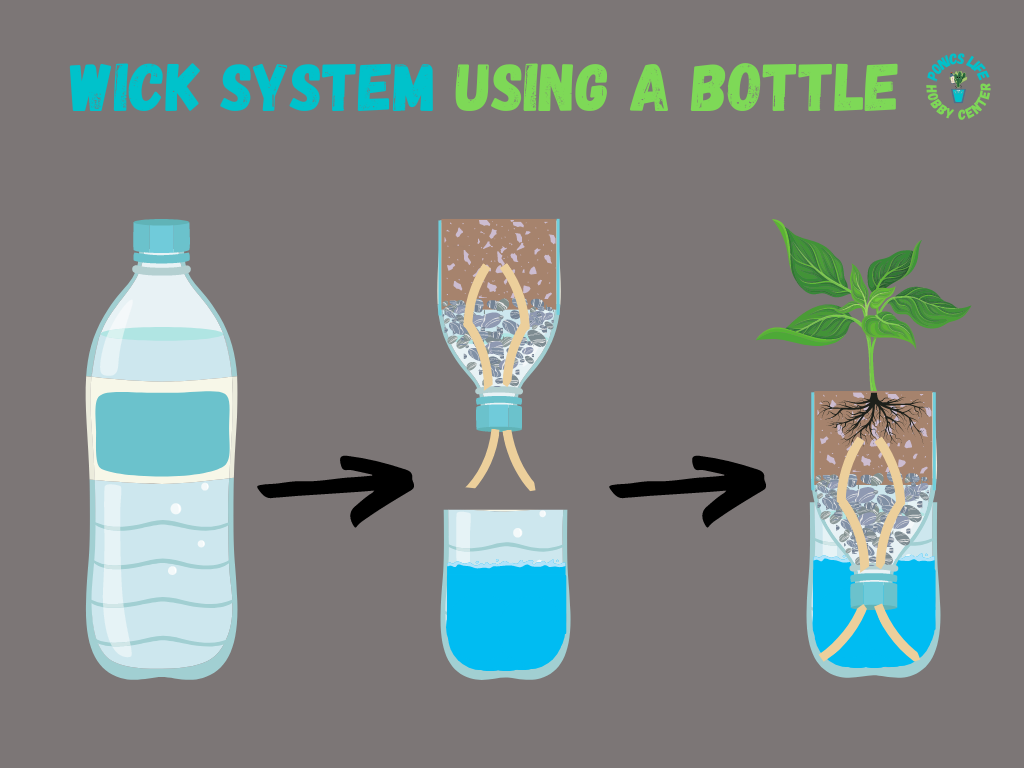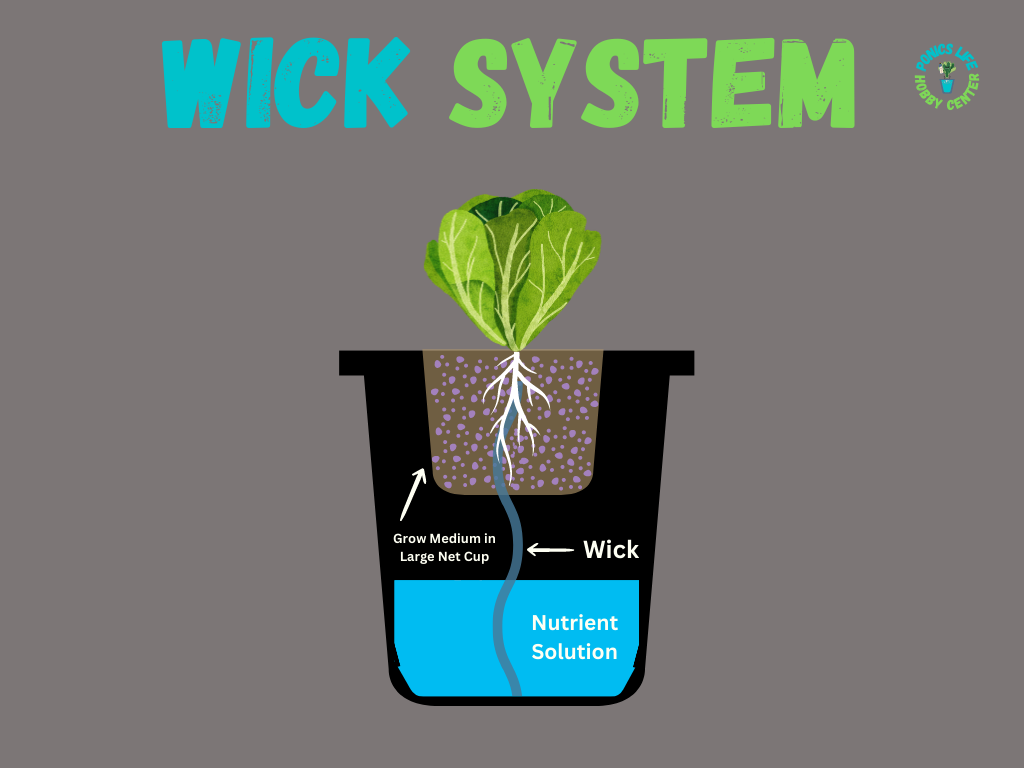Hydroponic wick systems are a type of soilless gardening that allows you to grow plants using only water, nutrients, and a wicking material. These systems are easy to set up and operate, making them a popular choice for beginners and first-time growers.
In a wick system, plants are grown in a container filled with a growing medium such as perlite, coconut coir, or vermiculite. A wick, made of materials such as cotton, nylon, or felt, extends from the bottom of the container into a reservoir of nutrient-rich water.
Using a process called “capillary action,” the wick draws up the solution from the reservoir and delivers it to the roots. This allows the plants to absorb the nutrients they need without the need for pumps or electricity.
Wick systems are low-cost and require minimal maintenance. They are also space-efficient, making them an ideal choice for small indoor gardens or balcony gardens. Additionally, wick systems can be used to grow a wide range of plants, from basil and cilantro to leafy greens like butterhead lettuce.
However, as we’ll discuss below, wick systems do have some limitations. They may not be suitable for larger plants that require more water and nutrients, and they are less efficient at delivering nutrients to plants with high nutrient demands. Moreover, wick systems can lead to a buildup of mineral salts in the growing medium, which can harm the plants if not flushed regularly.
If you’d like to learn more, read over the information below and learn how to build your own. Or, if you’re interested in other hydroponic systems, check out our Hydroponics Hobby Center for the latest and greatest information.

Wick System Advantages
Wick systems are a popular choice for hydroponic gardening for several reasons. Here are some of the advantages of using a wick system:
1. Low-cost: Wick systems are one of the most affordable types of hydroponic systems available. They require minimal equipment, and the materials needed to build one can be easily found at a hardware store or online.
2. Easy to set up and maintain: Wick systems are easy to set up and operate, making them ideal for beginners in hydroponic gardening. They require minimal maintenance, and the absence of pumps or electricity means that there are fewer components to maintain or replace.
3. Space-efficient: Wick systems are perfect for those with limited space, as they are small and compact. They can be set up indoors, on a balcony, or in a small backyard.
4. Suitable for a variety of plants: Wick systems can be used to grow a wide variety of plants, including herbs, leafy greens, and small fruiting plants such as strawberries.
5. Water efficiency: The wick draws up water from the reservoir as needed, making wick systems water-efficient. They are an ideal option for those who want to conserve water while growing plants.
6. Low noise level: Since wick systems don’t require pumps or electricity, they operate quietly. This makes them a good choice for those who prefer a peaceful gardening experience.
Wick System Disadvantages
A major limitation of hydroponic wick systems is their inability to support larger plants that require more water.
These systems are best suited for smaller, non-fruiting plants, such as herbs and lettuce. And despite the wick’s ability to deliver moisture to the roots, larger plants need more water to thrive, and fruiting plants require even more water to support the growth of their fruit.
Furthermore, wick systems are less efficient at providing nutrients to plants, especially for plants with high nutrient demands. While herbs and lettuce are light feeders (as we’ll discuss below), heavier feeders such as tomatoes and peppers may outdo the wicks’ ability to supply nutrients.
Finally, wick systems lack the ability to deliver nutrients and water evenly to the plants. The plants take what they need, leaving the rest of the nutrients sitting in the growing medium. This can result in a toxic buildup of mineral salts.
To avoid this, it is important to flush excess nutrients from the root zone with plain water regularly, typically once a week.

Best Plants for the Wick System
While a wick system can support a variety of plants, some plants are better suited for this type of setup than others. Because a wick system doesn’t deliver nutrients at a high level, herbs and lettuces will probably do better.
- Herbs: Herbs such as basil, mint, parsley, and cilantro are well-suited for wick systems because they do not require large amounts of nutrients or water. They are also relatively small and can be grown in compact spaces.
- Leafy greens: Lettuce, spinach, and other leafy greens can also do well in wick systems because they have shallow roots and can tolerate fluctuations in water availability.
Grow Mediums to Use for the Wick System
The best growing medium for a hydroponic wick system should have high capillary action and good water retention properties, to ensure that the wick can draw enough nutrient solution to the plant roots. Here are some growing mediums that are commonly used in hydroponic wick systems:
1. Vermiculite: Vermiculite is a lightweight and porous mineral that can hold water and nutrients well. It has high capillary action, which makes it an ideal growing medium for wick systems.
2. Perlite: Perlite is a volcanic rock that has been heated to produce a lightweight and porous material. It can hold water and nutrients well, and its high capillary action makes it suitable for wick systems.
3. Coconut coir: Coconut coir is a byproduct of coconut processing, and it is a renewable and sustainable growing medium. It has high water retention properties and good capillary action, which makes it suitable for wick systems.
4. Rockwool: Rockwool is a mineral wool made from basalt rock and other materials. It is a popular growing medium in hydroponics due to its high water retention and good drainage properties. It can also be used in wick systems.
5. Oasis cubes: Oasis cubes are foam cubes that are designed for use in hydroponics. They are lightweight and have good water retention properties, making them suitable for wick systems.
Ultimately, the choice of growing medium for a hydroponic wick system will depend on various factors such as the plant species, the nutrient solution, and the environment. As you build up your skills, test different options to find the best fit for your specific setup.

Materials You’ll Need to Get Started
Getting started with wick systems is fairly easy and most of the items you need can be found online or at a local supply store.
Here’s a quick breakdown of materials needed for hydroponic wick systems:
- Containers: if you’re not doing a bottle-sized wick system or 5-gallon bucket design, you’re going to need two containers (Small bin, Tupperware container, cookie jar, 5-gallon bucket, plastic bin, etc.). One will be your central reservoir that holds and supplies your nutrient solution, and the other will hold your plants and growing media.
- Wick: there are a lot of options when it comes to what “type of material” to use for your wicks (mop strand, tiki torch wicks, shoelaces, strips of cotton fabric, etc.), however, we recommend you use some self-watering wicking cord/rope since it’s already designed for this use.
- Nutrient Solutions: just like any other hydroponic system, nutrients are important. If you’re new to hydroponics, try reading our hydroponic nutrients guide to learn more.
- Growing Medium: as long as your growing medium is absorbent, your wick system should work just fine. For best results, try using coco coir, perlite, or vermiculite. If these aren’t available to you, give our hydroponics growing medium guide a read and see if there’s something else that would work.
How to Build Your Own Wick System
Building your own wick system is a relatively simple and inexpensive process. Here are the steps to follow:
Instructions:
1. Choose two containers for your system — one will serve as your reservoir (bottom container) and one will hold your plants and the growing medium (top container).
2. Cut a hole in the top of your reservoir container and the bottom of your plant container that is roughly the same size as your wick material. You can use a drill or scissors to make the hole.
3. Thread the wick material through the holes, so that one end hangs down into your reservoir and the other end protrudes out of the lid and into your “root area.”
4. Fill the top container with the growing medium, leaving enough space for the plant roots.
5. Place your plant(s) in the container and position the wick so that it touches the growing medium near the plant(s) roots.
6. Fill your reservoir with nutrient solution. The wick will draw up the solution to the roots as needed.
7. Make adjustments if needed and place your system in a well-lit area.
8. Monitor your plants and nutrient solution level and add more as needed.
That’s it! With a little patience and care, you can grow healthy, thriving plants using your homemade wick system.
Frequently Asked Questions
Are Wick Systems Expensive?
No, wick systems are not expensive. In fact, out of all the hydroponic systems, wick systems are the most affordable (mainly because they don’t require pumps).
Can I Build a Wick System with Stuff around the House?
Yes, a wick system is an easy to build system that you should be able to build one with stuff lying around the house. As pictured above, you can even use a 2-liter bottle.
Are there Other Hydroponic Systems that are Easy to Build?
Absolutely! Check out our “Types of Hydroponic Systems” guide or explore our Hydroponic Hobby Center.






